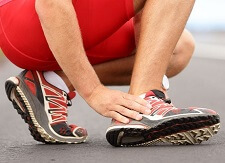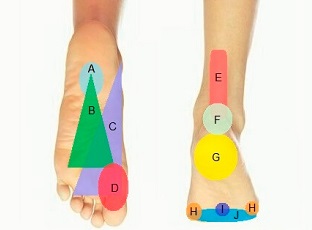- Home
- Foot & Ankle Exercises
- Peroneal Tendonitis Exercises
Peroneal Tendonitis Exercises
Written By: Chloe Wilson BSc(Hons) Physiotherapy
Reviewed By: FPE Medical Review Board

Peroneal tendonitis exercises are a great way to treat outer foot pain.
Peroneal tendonitis is an overuse injury that causes pain and weakness in the tendons that run over the outer ankle and foot.
Repetitive overloading or stretching leads to tearing and inflammation in the peroneal tendons, often affecting runners and athletes.
The good news is that the right exercises for peroneal tendonitis can make a huge difference in easing pain, improving ankle strength, and preventing the problem from coming back.
Here we will start by briefly looking at what peroneal tendonitis is including common causes and symptoms, and then go on to look at the best strengthening and stretching exercises for peroneal tendonitis. You will also find lots of top tips on how to make the best recovery and answers to the most frequently asked questions about peroneal tendonitis exercises.
What is Peroneal Tendonitis?
Peroneal tendonitis occurs when there is inflammation or irritation of the peroneal tendons, two strong cords that run down the outside of your lower leg and wrap behind the ankle bone to attach to the foot.

The two peroneal tendons are:
- Peroneus Longus: runs under the foot and attaches near the base of the big toe.
- Peroneus Brevis: attaches to the outside of the foot near the base of the fifth metatarsal.
These tendons help stabilise your ankle and foot during walking and running, preventing the ankle from rolling inwards.
Peroneal tendonitis pain is usually felt along the outside of the ankle, sometimes radiating into the foot, and can worsen with activity or on uneven surfaces. The pain usually builds up gradually over a few weeks and tends to be worse in the mornings or when your twist your foot inwards.
Peroneal tendonitis is typically caused by:
- Overuse or repetitive ankle movements
- Tight calf muscles or Achilles tendon
- Weak ankle stabilisers
- Poor footwear or high arches
- Previous ankle sprains or instability
- Muscle imbalance
That is where peroneal tendonitis exercises come in - they target the root cause by restoring flexibility and strength to the tendons and surrounding muscles.
Benefits Of Peroneal Tendonitis Exercises
Targeted exercises to help peroneal tendonitis are crucial for both recovery and prevention. Rest alone might ease symptoms temporarily, but without restoring flexibility and strength, the problem often returns.
Exercises for peroneal tendonitis help to:
- Reduce pain and inflammation
- Improve ankle flexibility and stability
- Strengthen the peroneal muscles and tendons, and surrounding ankle muscles
- Improve balance and stability
- Prevent recurrence of injury
You’ll get the best results from peroneal tendonitis exercises by combining stretching, strengthening, and balance training consistently, several times per week.
Best Strengthening Exercises for Peroneal Tendonitis
Strengthening peroneal tendonitis exercises help restore stability, strength and control around the foot and ankle, which not only help to treat peroneal tendonitis, but also help reduce the risk of recurrence.
If the muscles are weak, more strain goes through the tendons which increases the risk of developing peroneal tendonitis, so strength is key.
1. Alphabet Writing
This is a great place to start with exercises to help peroneal tendonitis as it gets the foot and ankle moving in all different directions but without putting much strain through the tendons.
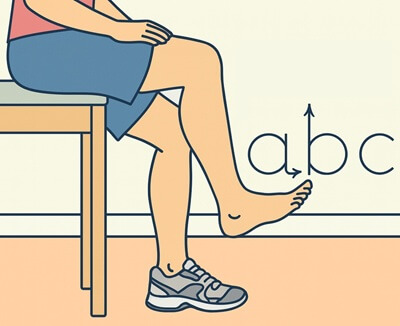
- Sit in a chair with your foot
raised up off the floor
- Write out the alphabet in the air
with your big toe, from A to Z
- Your ankle should be moving as
you write each letter
- Spend 2-3 minutes doing this
Tip: keep each letter movement specific and controlled
Variations: you can write words instead for some variety, just make sure you keep varying the letters you use so the ankle moves in all directions, and alternate between capital and small letters
2. Self-Resisted Eversion
This is a good place to start with working on eversion strength, the main movement performed by the peroneal muscles.
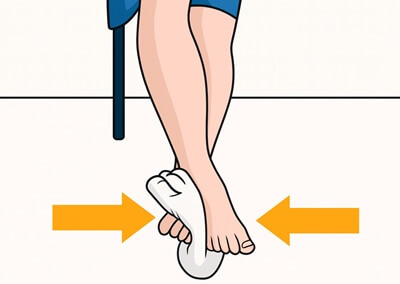
- Sit comfortably in a chair with your feet crossed and a small folded towel in between your feet
- Press the sides of your feet together as shown, squashing the towel
- Hold for 5 -10 seconds and repeat 10-15 times
- Then cross your feet over the opposite way and repeat
3. Eversion with Resistance Band
This is an excellent progression exercise for strengthening the peroneal muscles and tendons. Resistance bands come in a range of thicknesses so you can gradually increase the resistance to challenge the muscles further as you get stronger.
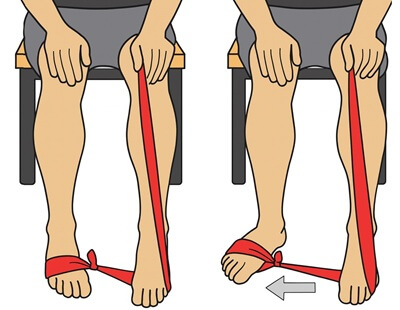
- Loop a resistance band around your foot and anchor it by hooking it under your opposite foot and up to your hand
- Start with the foot to be worked pointing inwards, foot flat on the floor
- Draw the band out to the side, sliding your foot across the floor
- Hold for 3 seconds, slowly return to the starting position and repeat 15-30 times
- Keep your heel in contact with the floor the whole time
Progression: Increase the tension through the band in the starting position to work harder
Variation: tie the resistance band to something sturdy e.g. a table leg rather than anchoring it under your foot
4. Heel Raises
Heel raises are excellent exercises for peroneal tendonitis as they target the calf muscles which help the peroneal muscles to support the foot and ankle.
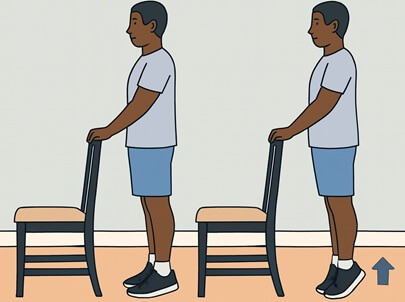
- Stand on both feet with your hands resting on a wall or chair for balance
- Slowly rise up onto your toes, lifting your heels off the floor, as high as you can
- Hold for 3-5 seconds and slowly lower down
- Repeat 15–30 times
Tip: don’t rush! Going slowly works the muscles much harder than going quickly
Progression: Try single-leg heel raises or perform the exercises on a step (first on both feet, then on just one) for a greater challenge.

5. Side Steps with Resistance Band
This is a very active strengthening peroneal tendonitis exercise that combines weight-bearing and movement, making it great for restoring function.
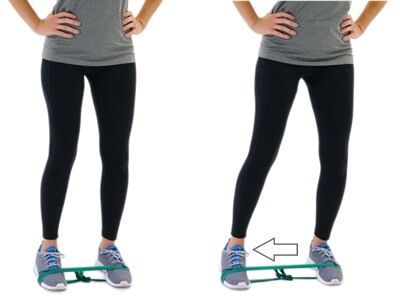
- Place a resistance band around the balls of your feet
- turn your feet slightly outwards into eversion so pulling on the band
- Bend your knees slightly and step sideways, keeping tension in the band the whole time
- Do a few steps in one direction, then reverse the direction and repeat 10-30 times each way
Tip: Keep your feet pointing slightly outwards and stay low to maintain tension through the legs.
Best Peroneal Tendonitis
Stretching Exercises
It is really important to do stretching exercises for peroneal tendonitis as well as strengthening exercises to ensure there is good flexibility and mobility in the foot and ankle.
1. Standing Calf Stretch
Tightness is the calf muscles can increase the strain through the peroneal tendons so this is a good place to start.
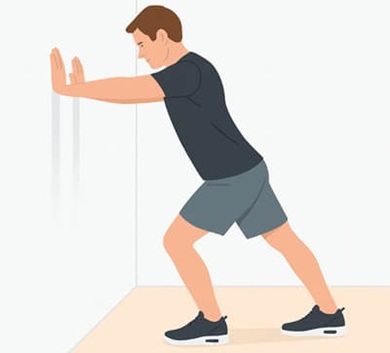
- Stand facing a wall with your hands resting on it
- Step your affected leg back, keeping your knee straight and heel flat
- Lean forward from the hips until you feel a stretch in the back of your calf
- Hold for 30 seconds, repeat 3 times
Tip: Keep your back foot pointing straight ahead, not out to the side. Don’t bounce - hold the stretch steady.
Variation: this exercise stretches the gastrocnemius calf muscle. To stretch the other calf muscle, soleus, bend the back knee slightly from the stretched position
2. Step Calf Stretch
This is another great way to stretch the calf muscles without having to lunge.
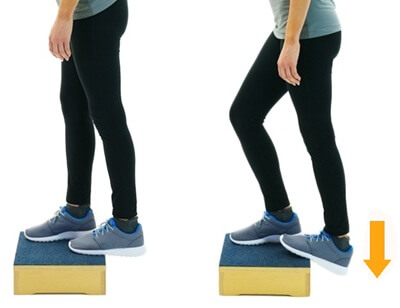
- Stand on a step with the target heel hanging off the back of the step
- Lower your heel towards the floor, keeping the knee straight, until you feel a stretch along the back of your calf
- Hold for 30 seconds and repeat 3 times
Variation: this exercise stretches the gastrocnemius calf muscle. To stretch the other calf muscle, soleus, bend the back knee slightly as you lower the heel
3. Peroneal Tendon Stretch
This is a great stretching exercise for peroneal tendonitis which focuses on stretching the peroneal muscle directly, releasing tightness along the outer lower leg and foot.

- While seated, cross
your legs so the foot to be stretched is resting on the opposite knee
- Hold onto your foot and
gently draw it upwards until you feel a stretch along the outer side of your
ankle
- Hold for 30 seconds and
repeat 3 times
Stretching exercises for peroneal tendonitis should ideally be done twice a day to ensure you regain full range and mobility in the ankle and reduce the strain through the peroneal tendons.
Balance Training
The peroneal muscles play an important role in ankle stability so it is important to include balance retraining into your program of peroneal tendonitis exercises.
1. Single Leg Standing
There are lots of variations of this balance exercise so you can challenge yourself more as you progress through your peroneal tendonitis exercise program. Perform barefoot if possible to strengthen the small stabilising muscles of the foot.
- Stand holding onto a chair for balance if need
- Lift one foot up off the floor so you are balancing on 1 leg
- Try and hold this position for 1-2 minutes then swap legs
Progressions: don’t hold on to anything
: close your eyes
: throw and catch a ball against the wall in front of you or with someone else
: stand on a cushion or rolled up towel so you are on a wobbly surface
Tip: fit this into your daily routine easily by standing on one leg when brushing your teeth or waiting for the kettle to boil
What Else Can Help?
Exercises for peroneal tendonitis are one of the most important parts of rehab but there are other things that can also help:
- Avoid aggravating activities like running or jumping until pain improves.
- Ice the ankle for 10–15 minutes after exercise or activity to reduce inflammation.
- Wear supportive shoes or ankle braces if needed during recovery.
- Progress slowly – it is better to do a little daily than to overdo it and flare symptoms.
- Include rest days to allow the tendons to recover and adapt.
If your pain hasn’t improved after 2–3 weeks of consistent peroneal tendonitis exercises, or you are struggling to walk without discomfort, it is best to seek professional advice.
A physical therapist can:
- Check your ankle mechanics and gait
- Identify strength or flexibility imbalances
- Use manual therapy and taping techniques
- Design a tailored exercise progression for full recovery
Find out more in the peroneal tendonitis treatment section.
FAQ’s For Peroneal Tendonitis Exercises
Let’s have a look at answer to some of the most frequently asked questions about exercises for peroneal tendonitis.
1. What
Are The Best Exercises For Peroneal Tendonitis?
1. What Are The Best Exercises For Peroneal Tendonitis?
The best exercises for peroneal tendonitis are those that gently stretch tight tissues and progressively strengthen the ankle to support the peroneal tendons.
Key exercises include:
- Calf stretches: loosen tight calf muscles and Achilles tendon that can overload the peroneal tendons.
- Peroneal tendon stretching: gently stretches the outer ankle and foot.
- Resistance band eversion: strengthens the peroneal muscles, which stabilise the ankle.
- Heel raises: improve calf strength and tendon endurance.
- Balance and proprioception work: like single-leg standing or wobble board exercises, which retrain ankle control.
When done regularly, these movements help reduce pain, restore ankle stability, and prevent re-injury. For best results, combine peroneal tendonitis stretching exercises with strengthening and balance training.
2. How Often Should I Do Peroneal Tendonitis Exercises?
2. How Often Should I Do Peroneal Tendonitis Exercises?
For mild to moderate symptoms, aim to do your stretching exercises for peroneal tendonitis two to three times a day and strengthening exercises once a day.
Start with gentle stretches in the morning and after activity to maintain flexibility, and perform strengthening work once daily when pain allows.
Consistency is more important than intensity — you don’t need to push hard; you just need to do them regularly.
If you overdo it, the tendons can become irritated again, so progress gradually and listen to your body. If you are unsure, a physical therapist can help you structure a tailored peroneal tendonitis exercise plan for your stage of recovery.
3. What Exercises Should I Avoid with Peroneal Tendonitis?
3. What Exercises Should I Avoid with Peroneal Tendonitis?
Avoid any high-impact or high-load exercises that put extra stress on the peroneal tendons until pain settles. This includes running, jumping, hill walking, and heavy resistance band work. Steer clear of side-to-side ankle movements and balance training on unstable surfaces early on, as these can aggravate symptoms.
Skip any single-leg hops, or stretches that cause pain. Instead, stick to gentle stretching and pain-free strengthening until your ankle feels stronger.
If exercises make your pain worse or it lasts more than a few weeks, see a physical therapist for tailored advice and a safe progression plan.
4. How Long Does It Take For Peroneal Tendonitis To Heal With Exercise?
4. How Long Does It Take For Peroneal Tendonitis To Heal With Exercise?
Healing time varies from person to person, but most people start noticing improvement within 4–6 weeks of consistent exercises for peroneal tendonitis.
Tendon recovery is a gradual process because tendons have a lower blood supply compared to muscles. For many, full recovery takes around 8–12 weeks, especially if the condition has been present for a while.
During the first few weeks, stretching and gentle mobility are the focus. As pain settles, strengthening and balance work become the priority. If you return to running or sports too early, symptoms can easily return, so it is important to progress slowly and maintain your peroneal tendonitis exercises even after pain improves.
If symptoms persist beyond 3 months, seek advice from a physiotherapist to check for biomechanical issues or other underlying causes.
5. Should I Stretch If My Ankle Is Sore?
5. Should I Stretch If My Ankle Is Sore?
Yes it is fine to do stretching exercises with foot tendonitis, but with care. Gentle peroneal tendonitis stretching exercises can help reduce stiffness and improve circulation to the healing tendon, even when your ankle feels sore.
Focus on low-intensity stretches that feel comfortable. You should feel mild tension, not sharp pain. Avoid holding positions that cause discomfort or increase swelling afterwards.
If your ankle is very tender or swollen, take a rest day and apply ice for 10–15 minutes before resuming. Once the pain eases, continue gentle stretching exercises to help peroneal tendonitis to maintain flexibility and prevent stiffness.
Remember, stretching should relieve discomfort, not aggravate it.
6. Can Exercises Make Peroneal Tendonitis Worse?
6. Can Exercises Make Peroneal Tendonitis Worse?
Yes, if done too soon, too forcefully, or with incorrect technique. Overloading a painful tendon delays healing and can turn mild tendonitis into chronic tendinopathy.
To avoid this:
- Start with gentle range of motion and stretching exercises before progressing to strengthening.
- Avoid jerky, fast, or weighted movements early on.
- Stop any exercise that increases pain during or after.
- Focus on controlled, slow motions - tendons respond best to gradual loading.
If pain increases after starting exercises for peroneal tendonitis, reduce the intensity or frequency for a few days, then slowly build up again. A physical therapist can check your technique and ensure you are using the right level of resistance for your stage of recovery.
7. Do Peroneal Tendonitis Exercises Help Prevent Recurrence?
7. Do Peroneal Tendonitis Exercises Help Prevent Recurrence?
Absolutely. Once your pain settles, continuing with your exercises to help peroneal tendonitis helps keep the ankle strong, flexible, and stable which is key to avoiding future flare-ups.
The peroneal tendons are especially active when balancing or walking on uneven ground. Regular strengthening improves your ankle’s ability to adapt to these stresses.
It is a good idea to keep doing your eversion band exercises and balance work two or three times a week even after full recovery. Pair that with supportive footwear and stretching after long runs or workouts, and you will greatly reduce your risk of recurrence.
8. What Other Treatments Help Alongside Peroneal Tendonitis Exercises?
8. What Other Treatments Help Alongside Peroneal Tendonitis Exercises?
Exercises to help peroneal tendonitis are the foundation of recovery, but combining them with other simple treatments can speed healing:
- Ice Therapy: Apply an ice pack for 10–15 minutes after activity to reduce pain and swelling.
- Massage Or Foam Rolling: Gently massage the outer calf and foot to release tension and improve blood flow.
- Supportive Footwear: Choose shoes with good arch and lateral support - avoid unsupportive, worn-out trainers.
- Ankle Taping Or Bracing: Offers temporary support if you need to stay active during recovery.
- Orthotics: Custom or off-the-shelf insoles can improve foot alignment and reduce strain on the tendons.
If symptoms persist, a physical therapist might also use ultrasound, shockwave therapy, or manual mobilisation to complement your peroneal tendonitis exercise programme. Find out more about peroneal tendonitis treatment.
9. When Should I See A Doctor Or Physical Therapist?
9. When Should I See A Doctor Or Physical Therapist?
You should see a physical therapist or doctor for peroneal tendonitis if:
- Your pain hasn’t improved after 6–8 weeks of consistent exercises.
- Pain is getting worse or spreading further up the leg.
- There is swelling, weakness, or a snapping sensation behind the ankle.
- You are unable to walk normally or return to sport.
A physical therapist can assess your ankle mechanics, identify contributing factors like calf tightness or flat feet, and guide you through a structured rehab plan. They can also rule out other causes of lateral ankle pain such as ankle instability, fibular stress fracture, or tendon subluxation.
Early professional advice helps ensure your recovery is complete and prevents the problem from becoming chronic.
Peroneal Tendonitis Exercises Summary
Peroneal tendonitis exercises are one of the most effective ways to relieve pain on the outside of the foot, improve strength, and prevent re-injury.
The best exercises for peroneal tendonitis combine gentle stretching and progressive strengthening to reduce tendon irritation and restore stability and normal movement.
Combine peroneal tendonitis stretching exercises such as calf stretches and peroneal tendon stretches to loosen tight tissues, with strengthening moves like resistance band eversion, heel raises, and balance training for best results.
Aim to do exercises for peroneal tendonitis twice a day, gradually increasing the number of repetitions as pain improves. When performed consistently and alongside supportive footwear, rest, and ice, these peroneal tendonitis exercises can significantly speed up recovery and help stop symptoms returning.
Be patient - recovery can take several weeks, but consistency really does pay off.
Foot tendonitis can occur in other tendons, not just the peroneal tendonitis:
- Achilles Tendonitis: causes pain behind the ankle
- Posterior Tibial Tendonitis: causes inner foot pain
- Extensor Tendonitis: causes pain on top of the foot
- Anterior Tibial Tendonitis: causes pain at the front of the foot
You may also be interested in the following articles:
Related Articles
References
- Strengthening Exercises For Peroneal Muscles. Torbay & South Devon NHS Trust
- Stretches To Relieve Peroneal Tendonitis. Healthline
- Physical Therapy For Peroneal Tendonitis. VeryWell Health
Page Last Updated: 12th November, 2025
Next Review Due: 12th November, 2027
